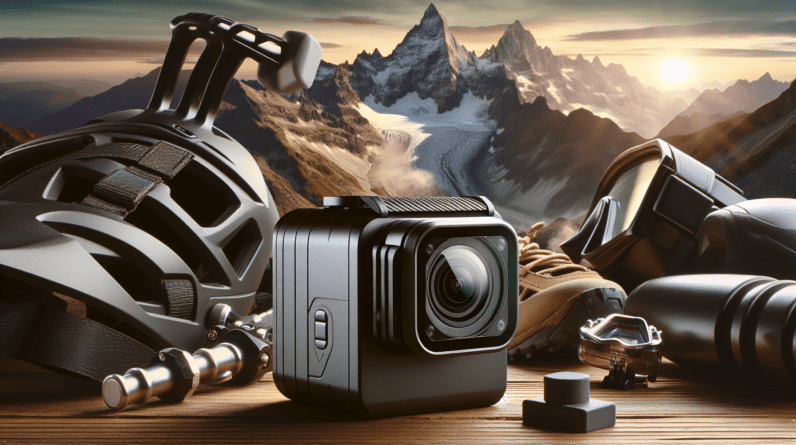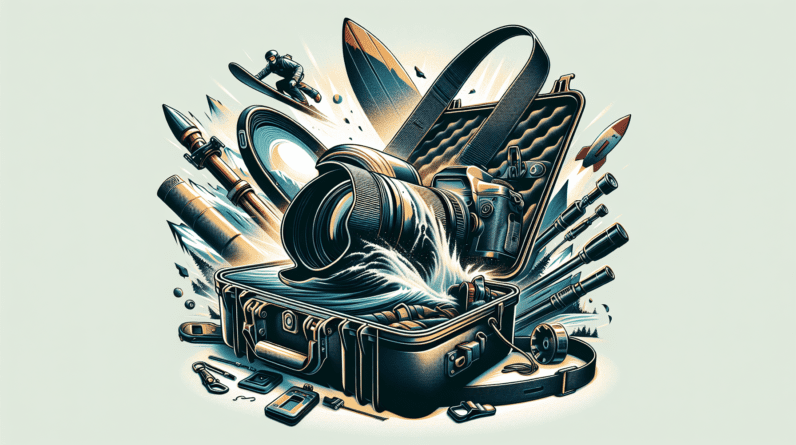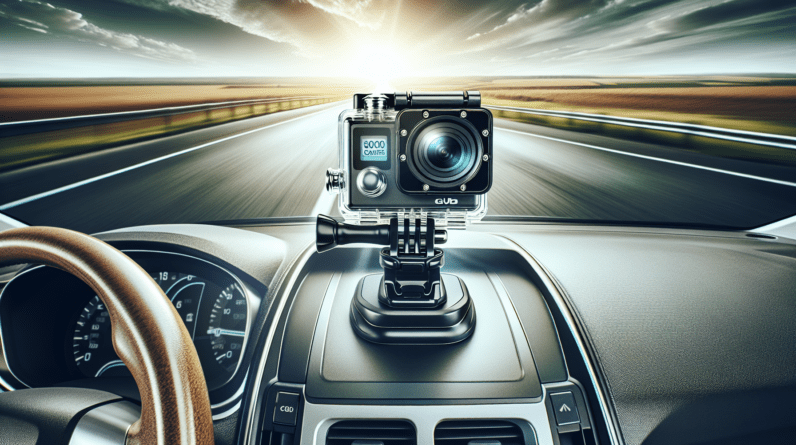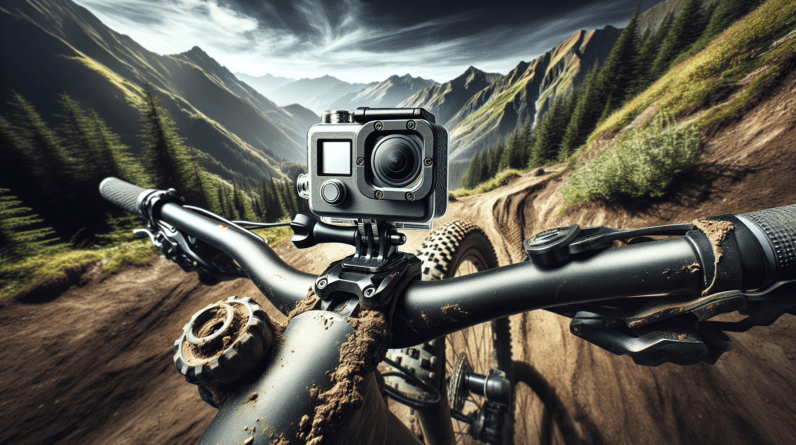If you’ve been considering purchasing an action camera, you’re in luck. This comprehensive guide will provide you with all the information you need to make an educated decision. Whether you’re an adventure enthusiast looking to capture your adrenaline-filled moments or a vlogger wanting to record your daily activities in high definition, we’ve got you covered. We’ll explore the top brands, key features, and important factors to consider when buying an action camera. So, grab your notepad and get ready to find the perfect camera to document your exciting escapades. Let’s jump right in!
Action Camera Buying Guide
Are you an adventurous spirit who loves capturing all the thrilling moments of your outdoor activities? If so, then an action camera is the perfect companion for you. Action cameras have become increasingly popular in recent years, thanks to their compact size, durability, and the ability to capture high-quality videos and photos in various extreme environments. However, with so many options available on the market, it can be overwhelming to choose the right one for your needs. That’s why we have created this comprehensive action camera buying guide to help you make an informed decision. Whether you are into traditional action cameras, 360-degree action cameras, or wearable action cameras, we’ve got you covered. Let’s dive in!
1. Types of Action Cameras
1.1 Traditional Action Cameras
Traditional action cameras are the most common type and are designed to be compact, lightweight, and easy to mount on various accessories. They are built to withstand rugged conditions and capture your adrenaline-filled moments with stunning clarity. These cameras are typically equipped with wide-angle lenses to capture a larger field of view and offer excellent image stabilization to ensure smooth footage even in the most action-packed scenes. Traditional action cameras are available in a wide range of resolutions, frame rates, and price points, making them suitable for everyone from beginners to professional adventure enthusiasts.
1.2 360-Degree Action Cameras
If you want to take your action videos to the next level and capture the full immersive experience, 360-degree action cameras are worth considering. These cameras utilize multiple lenses to capture footage in all directions, allowing you to relive your adventures from every angle. With the help of software, you can stitch together the footage to create a fully interactive and dynamic 360-degree video. Whether you are mountain biking, skiing, or scuba diving, a 360-degree action camera will enable you to capture every breathtaking moment and share it with your friends and family.
1.3 Wearable Action Cameras
Wearable action cameras are designed to be worn on your body, providing a unique perspective to your videos and photos. These cameras are compact, lightweight, and usually come with built-in mounting solutions, making them convenient to use and less intrusive. Whether you want to mount the camera on your helmet, chest strap, or even your wrist, wearable action cameras offer versatility and freedom to capture the world from your point of view. These cameras often come with features like voice control, making it easier than ever to operate them hands-free.
2. Key Features to Consider
When choosing an action camera, it’s essential to consider several key features to ensure it meets your specific requirements. Here are the crucial factors you should take into account before making a purchase:
2.1 Image and Video Quality
The image and video quality play a significant role in determining the overall performance of an action camera. Higher resolution and frame rate will allow you to capture sharper and smoother footage. Look for a camera that offers at least 1080p Full HD resolution or higher for crisp videos and photos. Additionally, consider the megapixels the camera offers, as this will determine the quality and level of detail in your photos.
2.2 Durability and Waterproofing
Since action cameras are meant to be used in extreme conditions, durability is paramount. Look for cameras that come with a sturdy housing or casing to protect them from impacts and harsh elements. Furthermore, check the waterproof rating of the camera. If you plan on capturing your underwater adventures, make sure the camera is waterproof to the depth you will be diving.
2.3 Battery Life
Battery life is an essential consideration, especially if you plan on recording for extended periods or in remote locations where charging options may be limited. Look for an action camera with longer battery life or conveniently replaceable batteries, so you never miss capturing those thrilling moments.
2.4 Field of View
The field of view (FOV) determines how much of the scene the camera can capture. A wider FOV is ideal for action shots, as it allows you to capture more of the surroundings and creates a more immersive experience. Look for cameras with a wide-angle lens or adjustable FOV to ensure you can capture the entire action.
2.5 Image Stabilization
To avoid shaky and blurry footage, image stabilization is an important feature to consider. Optical image stabilization (OIS) and electronic image stabilization (EIS) help compensate for camera movements, ensuring smooth and steady footage even on rough terrains or during fast movements. Look for cameras that offer advanced stabilization technologies for the best results.
2.6 Connectivity Options
Being able to share your adventures instantly is a significant advantage of action cameras. Look for cameras that offer Wi-Fi and Bluetooth connectivity, allowing you to easily transfer files to your smartphone or tablet. Some cameras also come with NFC (Near Field Communication) and GPS capabilities, which can enhance your overall experience and allow you to track your adventures.
2.7 Mounting Options
One of the key advantages of action cameras is their ability to mount on various accessories, enhancing the perspective and flexibility of your shots. Consider the compatibility of the camera with different mounting options, such as helmet mounts, chest mounts, bike mounts, and suction cup mounts. Having a wide range of compatible accessories will ensure you can capture your adventures from various angles and viewpoints.
2.8 User Interface and Controls
A user-friendly interface and intuitive controls are essential for smooth operation and quick access to features while on the go. Look for cameras with a simple and well-designed user interface, allowing you to navigate through settings effortlessly and focus on capturing the action.
2.9 Additional Features
Some action cameras offer additional features that can enhance your shooting experience. These may include voice control, built-in GPS, slow-motion recording, time-lapse, and compatibility with external microphones for better audio quality. Evaluate these features based on your specific needs and preferences.
2.10 Price
Lastly, consider your budget when choosing an action camera. Action cameras are available in a wide range of price points, from budget-friendly options to high-end models with advanced features. Determine your budget and prioritize the features that are most important to you to find the perfect balance between price and performance.
3. Image and Video Quality
When it comes to image and video quality, there are several factors to consider to ensure you capture stunning footage. Let’s explore these factors in more detail:
3.1 Resolution
Resolution refers to the number of pixels that make up an image or video. Higher resolution results in sharper and more detailed footage. Most action cameras offer a minimum of 1080p Full HD resolution, which is suitable for everyday use. However, if you want to capture more intricate details or plan on editing your footage, look for cameras that offer higher resolutions such as 4K or even 8K.
3.2 Frame Rate
Frame rate determines the smoothness and fluidity of the video. It refers to the number of frames or images that are captured per second. Higher frame rates result in smoother playback and are particularly important for capturing fast action scenes. Look for action cameras that offer at least 30 frames per second (fps) at the minimum to ensure your footage is smooth and enjoyable to watch.
3.3 Megapixels
Megapixels (MP) determine the level of detail and sharpness in your photos. The higher the number of megapixels, the more detailed the image will be. Most action cameras offer between 10MP and 20MP, which is sufficient for most photography needs. However, if you plan on printing your photos or require professional-level quality, consider cameras with higher megapixel counts.
3.4 Video Formats
Action cameras support various video formats, including the popular MP4 and AVI formats. Some cameras also offer advanced formats such as HEVC (High-Efficiency Video Coding) or H.264, which provide better compression and allow you to capture more footage in less storage space. Consider the compatibility of the camera’s video formats with your editing software or viewing devices to ensure smooth playback and editing capabilities.
4. Durability and Waterproofing
Action cameras are designed to accompany you on your most extreme adventures, so durability and waterproofing are essential considerations. Let’s explore what to look for in terms of durability and waterproofing:
4.1 Housing and Protection
To ensure your action camera can withstand rugged conditions, check if it comes with a sturdy housing or casing. The housing should protect the camera from impacts, scratches, and dust. It should also provide easy access to the camera’s buttons and controls, allowing you to operate it smoothly even in challenging environments.
4.2 Waterproof Rating
If you plan on capturing your underwater adventures, make sure your action camera is waterproof. Action cameras come with different waterproof ratings, indicated in meters or feet. For instance, a camera with a waterproof rating of 10 meters (33 feet) means it can be submerged in water up to that depth without any damage. Consider the depth you will be diving or swimming in and choose a camera with an appropriate waterproof rating.
4.3 Shockproof and Dustproof
In addition to waterproofing, consider if the camera is shockproof and dustproof. These features ensure your camera can withstand accidental drops, impacts, and exposure to fine particles. Look for cameras that are specifically designed to be shockproof and dustproof, so you can confidently use them in any environment without worrying about damage.
5. Battery Life
When you’re out on an adventure, the last thing you want is for your action camera’s battery to die in the midst of capturing an exciting moment. Consider the following aspects related to battery life:
5.1 Battery Capacity
Battery capacity determines how long your action camera will last on a single charge. It is measured in milliampere-hours (mAh). The higher the number of milliampere-hours, the longer the battery will last. Look for action cameras with larger battery capacities, such as 1000mAh or higher, to ensure you have enough power to capture your adventures.
5.2 Replacement Options
In case you don’t have access to charging options while on the go, it’s useful to have the option to replace the battery. Some action cameras come with removable batteries, allowing you to carry spare batteries and swap them out when needed. This ensures you can continue recording without interruptions.
5.3 Continuous Recording
Consider the camera’s continuous recording capability, especially if you want to capture long events or record videos without pausing. Some cameras have limitations on continuous recording time, while others can record for hours on end. Check the camera’s specifications to determine its continuous recording capabilities and choose the one that best suits your needs.
6. Field of View
The field of view (FOV) is an important aspect to consider when choosing an action camera. It determines how much of the scene the camera can capture within its frame. Here are the two key factors related to the field of view:
6.1 Wide Angle Lens
Most action cameras come with a wide-angle lens, which allows for a wider field of view. A wider FOV is ideal for capturing action shots, as it allows you to capture more of the surroundings and create a more immersive experience. Look for cameras with wide-angle lenses, preferably with FOVs of 150 degrees or higher, to capture the full scope of your adventures.
6.2 Adjustable Field of View
Some action cameras offer the flexibility to adjust the field of view to suit your specific needs. This allows you to switch between a wider angle for capturing vast landscapes or a narrower angle for detailed close-up shots. Consider cameras that offer adjustable FOV settings, so you can capture the perfect shot from any perspective.
7. Image Stabilization
Action cameras are often subjected to intense movements and vibrations, which can result in shaky and blurry footage. Image stabilization is an important feature that helps counteract these effects, ensuring your footage remains stable and smooth. Let’s explore the two types of image stabilization:
7.1 Optical Image Stabilization
Optical image stabilization (OIS) is a mechanical stabilization method that uses sensors and gyroscopes to detect camera movements. The camera’s lens or image sensor is then adjusted to compensate for these movements, resulting in smoother footage. OIS is particularly effective in reducing shaky footage caused by hand movements or vibrations.
7.2 Electronic Image Stabilization
Electronic image stabilization (EIS) is a software-based stabilization technique that uses algorithms to reduce camera shake. It works by cropping the edges of the footage and digitally realigning the footage to compensate for movements. While EIS may result in a slight reduction in the field of view, it is highly effective in stabilizing footage and ensuring smooth results.
Consider action cameras that offer advanced image stabilization technologies, such as a combination of OIS and EIS, to achieve the best stabilization results.
8. Connectivity Options
Being able to share your adventures instantly with friends and family is one of the great advantages of action cameras. Consider the following connectivity options to ensure you can easily transfer and share your footage:
8.1 Wi-Fi
Wi-Fi connectivity allows you to connect your action camera to your smartphone or tablet wirelessly. This enables you to transfer files effortlessly and control the camera remotely through a dedicated app. With Wi-Fi, you can instantly share your photos and videos on social media platforms or store them in the cloud for safekeeping.
8.2 Bluetooth
Bluetooth connectivity is another convenient option for transferring files from your action camera to your smartphone or tablet. It can also be used to connect the camera to other compatible devices, such as wireless headphones or speakers, for a seamless audio experience.
8.3 NFC
Near Field Communication (NFC) is a wireless technology that allows two devices to establish communication simply by touching or being in close proximity to each other. Some action cameras come with NFC capabilities, making it quick and easy to establish connections and transfer files.
8.4 GPS
Action cameras with built-in GPS capabilities allow you to track and record the exact location of your adventures. This feature can be useful for analyzing your routes, measuring your speed, or geo-tagging your photos and videos. Consider cameras with GPS if location tracking is important to you.
9. Mounting Options
One of the key advantages of action cameras is their ability to mount on various accessories, allowing you to capture unique perspectives and viewpoints. Consider the following mounting options available for action cameras:
9.1 Compatibility with Accessories
When choosing an action camera, ensure it is compatible with a wide range of accessories. Look for cameras that have a universal mount or are compatible with commonly used mounting systems like GoPro mounts. This opens up a world of possibilities for mounting your camera on different surfaces, vehicles, or equipment.
9.2 Helmet Mount
A helmet mount is a popular option for action cameras, particularly for activities like biking, skiing, or skateboarding. It allows you to capture the action from your point of view, providing a more immersive experience for viewers.
9.3 Chest Mount
A chest mount is ideal for activities where your head or helmet movement may be limited, such as kayaking, rock climbing, or motorcycling. It provides a stable and chest-level perspective, showing your hands and the surrounding environment.
9.4 Bike Mount
A bike mount is perfect for cyclists or motorcyclists who want to capture the thrill of their rides. These mounts are designed to securely attach your action camera to handlebars, seatposts, or other parts of your bike, ensuring stable footage even on rough terrains.
9.5 Suction Cup Mount
A suction cup mount offers the flexibility to mount your action camera on various flat surfaces, such as car windshields, surfboards, or paddleboards. Its strong suction enables a secure attachment, allowing you to capture dynamic footage even in fast-paced activities.
Remember to check if the action camera you choose comes with the necessary mount or if you need to purchase it separately. Having a wide range of compatible mounting options will enhance your ability to capture unique and engaging footage.
12. Price
Price is an important consideration when choosing an action camera. Here are the three main price ranges to consider:
12.1 Budget-Friendly Options
If you’re just starting with action cameras or have a limited budget, there are plenty of affordable options available. Budget-friendly action cameras offer basic functionalities, decent image and video quality, and reliable durability. While they may not have all the advanced features of higher-end models, they are still capable of capturing your adventures in great detail and allowing you to share them with others.
12.2 Mid-Range Options
Mid-range action cameras offer a balance between price and performance. With a slightly higher budget, you can enjoy better image and video quality, more advanced features like image stabilization and adjustable FOV, and improved durability. These cameras are suitable for enthusiasts who want to take their action footage to the next level without breaking the bank.
12.3 High-End Options
High-end action cameras are designed for professionals and serious adventure enthusiasts who require top-of-the-line features and exceptional performance. These cameras offer the best image and video quality, advanced stabilization technologies, extensive connectivity options, and rugged durability. If you are looking for the ultimate action camera experience and are willing to invest in premium features, high-end options are worth considering.
In conclusion, choosing the right action camera is a personal decision based on your specific needs, preferences, and budget. Consider the type of action camera that best suits your activities – traditional, 360-degree, or wearable. Evaluate the key features such as image and video quality, durability and waterproofing, battery life, field of view, image stabilization, connectivity options, mounting options, and additional features. Finally, determine your budget and choose the price range that offers the best balance between performance and affordability. With our comprehensive action camera buying guide, you are now equipped to make an informed decision and capture your thrilling adventures with ease. Have a great time exploring and recording your memories!






